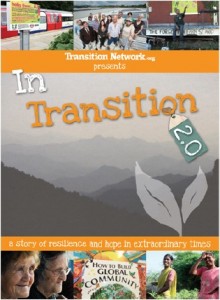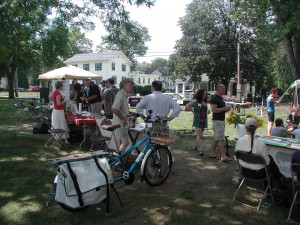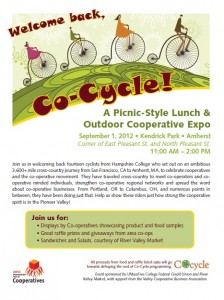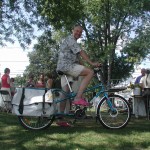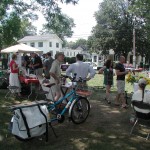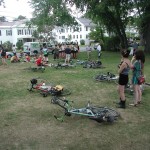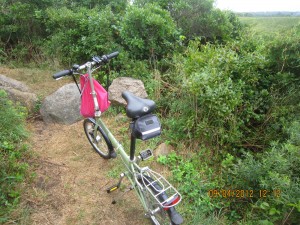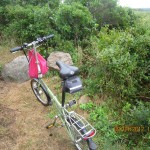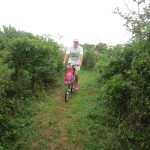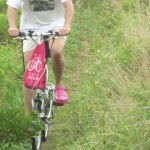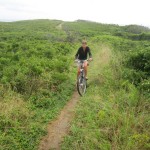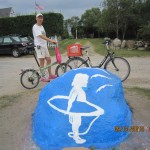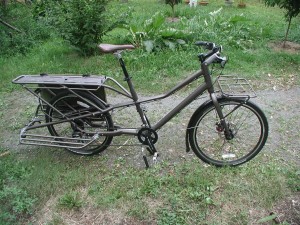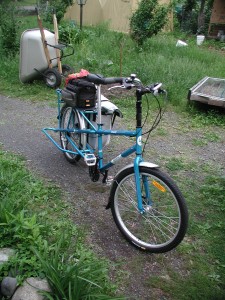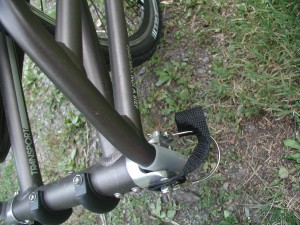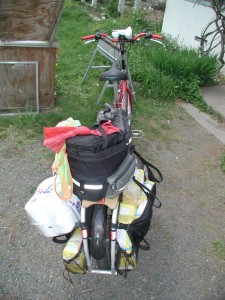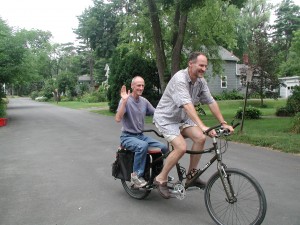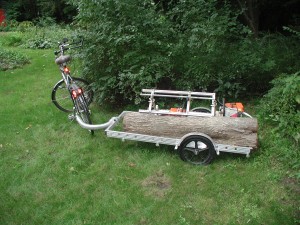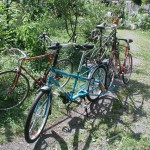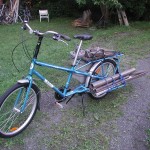
Carolyne Stayton
Emily Polk, activist, PhD candidate, and member of Transition Amherst met with Transition U.S.’s Executive Director Carolyne Stayton in Sebastopol, California to discuss the work of Transition projects around the country; different ways initiatives can get sustainable funding; how to engage with diverse members of a community; and the overall future of the Transition movement in the United States. Following is the transcript of this interview.
EP: I am interested in hearing about how you first heard about and became involved in Transition?
CS: I found out about it through two avenues. One was just by doing research that was looking at peak oil and climate change and was focused on local. I found the Kinsale energy descent action plan, and just thought it was so great that it was all put together and had a permaculture overlay.
EP: Had you done this work before?
CS: I have a permaculture design certificate and was working at the New College of California Sustainable communities campus. I was the campus director. Richard Heinberg was working there, and his whole peak oil work was being folded into our curriculum. We started the first green MBA in the country, and we started a second one that was focused on local business, which started my search. I wanted to know: “Who else is doing something in terms of local business that has the context of climate change and peak oil?” And then shortly thereafter Richard was doing a lot of touring and met Rob [Hopkins], so he found out about it early on. He would mention Transition towns as a solution, as what people can do. So I credit Richard to early-stage spreading of the Transition movement particularly in Australia and New Zealand and just a number of places. And then of course so much of it was viral spread. In the US, one of our New College students moved back to England and started the second Transition initiative and she was in touch with us and we identified a few other people who were just starting the Transition Network in the UK and the US. We started a little satellite group called Transition U.S. six months or so before we got the funding.
EP: How did you get funding?
CS: It came from one single donor who saw Transition as a very important step. He’s in this area. [Sebastopol, California] and he was brought forth to us through the Post Carbon Institute so we formed a working partnership with them which we still have and of course Richard Heinberg is now a fellow.
EP: Is that advice that you would give to other Transition Towns? Build those kinds of alliances with institutes and nonprofits? How do those connections work?
CS: Yes definitely build partnerships, collaborations, networks. The main goal in a place is to transition that place. And there are a lot of activities that are already alive in that place that are transitioning it. So cast the net and help each other to identify and make links and partnerships with all of the groups working in that vein.
EP: How does Transition U.S. partner with Transition Sebastopol? What’s the difference between the two?
CS: I wouldn’t say that’s a partnership because we’re national. Our partners are probably more on a larger scale than a local scale.
EP: Who are they and how do they work?
CS: They’re all different. We partner with Bioneers and with Generation Waking Up. Some we work on projects together, some we do maybe some simple things like give webinars. In terms of Post Carbon, Transition US and a number of organizations are participating with them to identify resiliency resources to get information out for a new website. There’s a great public interest law center called the Sustainable Economy Law Center that’s out in Berkeley. Janelle Orsi, an attorney focused on sharing law has written a book called the “Sharer’s Solution” and she’s done some webinars for us. They have put together a really in-depth resource site on everything you’ve needed to know about food ordinances, policies, laws, etc. so we’ll be featuring that. We’re also working with them and with Post Carbon Institute and Bioneers and Threshold Foundation and Bay Localize and Generation Waking Up to create a conference day before Bioneers dedicated to mapping the resilience field. So who’s in it, whose doing what. But in terms of a local initiatives partnering with other organizations, it’s basically about seeing who’s in that place…
EP: Does Transition US offer any framework or guidelines on how to do that? It’s been my experience that people are so busy, even when these connections are made, it’s hard to follow up.
CS: Well, Transition Chicago has done a really great job creating some asset mapping tools that are conducted by interns from universities that they work with who actually get that data from 77 neighborhoods. So that’s a little sophisticated, probably beyond most Transition initiatives, but I think the asset mapping tools can be used. We did a simple asset mapping exercise here where we convened a gathering where we said: “Let’s find out what we have and what we need.” About 300 people came and we went through a process of identifying: above the line what we have, below the line what we need in all of these categories people could think of.
EP: So what happens after a mapping project like this?
CS: Well we had a second one and then we broke into interest groups for each topic. An initiating group member took one or two topics and helped to initiate some of the working groups.
EP: How do you publicize an event like that? How do you get people to come?
CS: We handed out flyers for the second event. I think the first one came from a conversation with Richard Heinberg who lives in the area. It just hit the pulse somehow.
EP: So this brings us to an important question: How do you hit the pulse? How do you mobilize people to take these kinds of actions and then sustain their interest when their lives are already so busy?
CS: Yes, that is a question especially when people are doing this as volunteers. I think the key will be to bring money into the movement and create some livelihood. That’s the only way to make it sustainable. There’s a couple of different ways for that to happen. One is to identify a fiscal sponsor. An initiative can also become a nonprofit; it can become a coop.
EP: Have there been initiatives that have done this?
CS: Yes. In Sarasota Florida, there’s Transition Colorado, I think Sandpoint Idaho. I know Transition LA is looking at it. So fiscal sponsorship enables an initiative to raise money under the umbrella of an existing nonprofit that has a compatible mission. A more seasoned nonprofit or a community foundation often will provide that service of being a fiscal agent. They would take a percentage of the money that comes in and what they do for that percentage is they keep the books, they file the taxes, they do all the legal side. It can be anything like 4 percent to 12 percent.
EP: What is the process for people in Transition Towns to get those sponsorships?
CS: Well, it’s really just about identifying the nonprofits or foundations in your community who do such a thing so it’s fairly straight forward. But in terms of nonprofit status, that is more involved, it’s a little more paperwork and a little more thought. It’s different in every state. So what I would recommend first is that initiatives get a fiscal sponsor. As soon as they start bumping up against anything more than passing a hat at a movie. If there’s a small grant, even a neighborhood grant of $ 5 thousand, they’re interested in, they really need to have a fiscal sponsor. But the other side to bringing money in is creating local business. That’s really new for us in the U.S. But they’re a couple years ahead in the UK with Transition businesses. There’s a way of potentially structuring them depending on how it’s seeded. If it’s really the steering group that’s seeding the business, helping it, nurturing it, incubating it then the thought is that potentially the profits from the business go back to the social side of the nonprofit so that creates some sustainability.
EP: Do you see this as the next step for sustaining Transition Towns?
CS: Money has to come into it. Volunteers can only do so much. I mean it’s possible that successive waves of volunteers will continue the initiative. The other thing is to do some kind of collaborative fundraising with Transition U.S. or clusters of Transition initiatives that have fiscal sponsorship or nonprofit status. So you have clusters that might be working on similar themes: A food security theme, etc. An initiative in Wisconsin is going to be trying this with the school lunches program. In Pittsburgh Pennsylvania they’re going to work with food security issues but with the inner city and apply to a foundation.
EP: So what role does Transition US play in facilitating this?
CS: We, potentially depending on the skill or capacity of that cluster — I mean there might be some very seasoned fundraisers in that mix, but potentially there’s a role that we can play to hold the grant and hold the pieces together, maybe oversee the disbursement of funds. Maybe do something like host some webinars about the content.
EP: Right now do you see Transition Towns communicating/connecting with each other? And in what ways?
CS: Well, it’s fairly local focused. It’s pretty challenging to add on the next ring of coordination with those in the region because that’s just more time. I am seeing regions starting more slowly than I anticipated and I think that’s probably because of their capacity.
EP: What is Transition U.S. relationship to Transition Towns?
CS: We really see ourselves as a supporting organization by providing information and resources and mentoring and networking. Being a mirror so the movement can see itself. I don’t know if anybody else will be holding that data. “How many initiatives are there in the U.S.”? Or “Where are some of the mulling groups in the U.S.? What are some emerging resources or interests? What are some cutting edge things that initiatives are doing? What would be replicable?”
EP: What are some changes you’ve seen in the last few years?
CS: I think, again, money coming into some of the initiatives. With Transition Colorado they were successful in getting $ 1.2 million dollars of venture capital money to seed businesses to create more food security in the region. I think we also need to look big and think big. I think there are possibilities for some Transition initiatives to get government contracts. There are a couple of nonprofits that have some good models. We’re working with another set of collaborators on those models.
EP: Can you speak to why the Transition movement has spread so fast and become so popular even as many critique the environmental movement to be dead?
CS: From my own lens, knowing what I knew about peak oil, becoming more and more aware of climate change issues and not seeing much addressing those in any place – government, you name it. I think the Transition model worked because it was speaking to those issues and providing a means of action that was positive and hopeful. I just don’t think there’s anything else like that: Something that really addresses some fears and concerns in the population with actionable steps to take to do something about it. I think it’s a relief and a joy and offers a lot of possibility.
EP: Why has the movement remained largely white and educated?
CS: I think because those issues are more in the conversation of the educated population. Peak oil — when you’re just trying to get enough money to feed your family is kind of a distant thing. Or what’s happening with polar bears in the arctic. You know obviously weather severity has come home to the U.S. with quite a lot of impacts the last few years.
EP: So can a community be truly resilient if there isn’t the entire community participating?
CS: I don’t think it’s going to take the entire community. But you need a tipping point. I think we need to identify and nurture and connect with and develop relationships with all of the bridge people to other segments of the community because we’re all in this together.
EP: Does Transition US have any models or guidelines for how to go about doing that?
CS: No not really, but at the event in Chicago it was evident that that is happening. There were more youth, there were more ethnically diverse people.
EP: How many people were there?
CS: There were 16 new trainers and two of them under 30. That gives us a total of three under 30, of about 20 active trainers. And four people of color. So that’s a start isn’t it? It’s a movement and direction that we want to definitely continue.
EP: I am still not sure where people can go to find out how to engage all members of a community. Research just came out of the UK that noted the incorrectness of stating that we need to “include” everybody. It sounds condescending. Nobody’s asking to be included.
CS: Yes, it’s the same with “Outreach.” We need to “outreach to diverse communities.” It’s like “No you don’t.” People need to go to THEIR events. If they ask for money, give money. If they ask for support, give support. I mean it’s that simple, and it’s that not-simple because it is time consuming. But that’s how you do it. And in doing that you will meet someone who’s generally interested in what you’re doing. And then you say “Can you come and talk at our event and let us know what you’re doing and how you think it relates to what we’re doing.” We have just started to have some of those bridge people connect with the movement as Transition trainers.
EP: What do you find sustains participating in the Transition Towns? Are people seeing the impacts of their initiative?
CS: I think what we’ve done here [Transition Sebastopol] is a number of us started to join the grange. There are granges all over the country and now folks from Transition Sebastopol are the grange masters, overseers etc.
EP: How many people are involved with Transition Sebastopol?
CS: I think there are about 1000 people on it’s mailing list and I would say probably 100 members are members of the grange and that has breathed a certain kind of new life into things because there’s actually a building and a place to hold events. There’s that sort of infrastructure and the possibility of making a permaculture demonstration site on the property and potentially putting up a railway car full of emergency supplies for the community. So that’s a particular something. Maybe there needs to be a particular something that happens that kindles something…
EP: Are there young people who are involved?
CS: Yes, mostly young people who are interested in farming.
EP: Do you see any commonalities between rural and urban transition initiatives?
CS: It seems like the place where most people first get momentum and have interest is around food. And rightly so. Because that’s the main thing. We need to create that food security.
EP: Right now what are some of the most exciting projects you’re seeing?
CS: I like Transition Sarasota’s gleaning project. They were able to divert 4 or 5 tons to food banks through gleaning. [Picking over a harvest that’s already been picked.] And Transition Los Angeles is doing some great convening around local economy and what businesses might be developed. I think we’ll be seeing more focus on the economy, bringing money into this.
EP: Do you see the language of the movement changing to focus more on the economy and less on climate change or on the connections between the two? How do you think the language will reflect this shift?
CS: Transition is upon us, right? There’s droughts in the Midwest, people are selling off their livestock because they can’t feed them, the corn crop is failing. I think the main thing is to focus on community building and building resilience. It doesn’t matter what brings an area to its knees, it matters what the safety net is there to catch residents.
EP: What is the communication between Transition U.S. and Transition UK?
CS: It’s more conversational. “What do you think about this?” “Look at this, be aware of that.” It’s more peer-to-peer than reporting. It’s not formalized. Right now we’re having some conversations about youth. We are talking with Generation Waking up right now about people who are older who would want to mentor or support youth. So within an initiative there might be sort of a link there to support it which could be an extraordinarily potent partnership.
EP: Why do you think the model doesn’t attract large numbers of youth?
CS: I think it’s just on the point of doing so. There’s an amazing young man out of Prince Rupert British Columbia Lee Brain, there’s a youtube of him talking to government officials about the devastation of the oil industry from personal experience because his Dad is in it and going places over seas and seeing what oil companies have done to the people. He talks with such passion and he started the Transition initiative in Prince Rupert with his school teacher and they’re just gonna rock it.
EP: I think some youth might get frustrated if they don’t see immediate impacts right away. Young people might want to go to a meeting and have something happen. Sometimes the meetings can lead toward a little more processing than action and that might be hard for some young people?
CS: It does seem like there’s always going to be people who are more in the process side of things than the doing side and there’s just this tension. But you know the process people need to just let go of it sometimes and let the doers get something done or else they’ll lose all the doers and then it’s just talking. It kind of holds people hostage to be analyzing every single thing. The thing I like about the Transition Chicago initiative is the asset mapping really sends people door-to-door to find out what is happening in a community. Talk about feet-on-the-ground action. And it takes some capacity to hold that.
EP: Do you see yourself doing this forever?
CS: Well, we’re actually in the process of looking for a co-director. Transition U.S. is going to the next stage and that’s also happened with the trainers. We’ve just trained 16 remarkable, amazing people from all over the country, from petroleum geologists to university professors to Tibetan Buddhist nuns so that’s refreshed us and it’s time to refresh the organization. So there’s an opportunity for somebody to come in as a leader and help to take the organization to the next step. I feel like right now it’s the beginning of Chapter Two of Transition in the U.S. evidenced with the new trainers, with the advanced training we’ve just done, and the opportunity for new leadership in the organization. It’s a lovely moment.
***
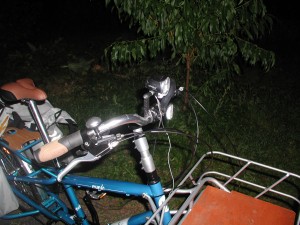 To be able to safely use your bike at all times of the day, you need to be able to see and be visible.
To be able to safely use your bike at all times of the day, you need to be able to see and be visible. 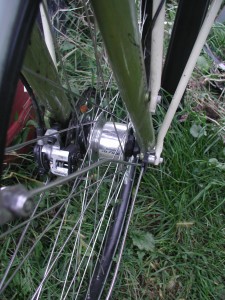 The system I have grown to like over the years for bicycle lighting has a hub-generator in the front wheel hub, so again, batteries are not a concern, a Busch&Muller head light, and a non-battery rear light (in my case also Busch&Muller, so they work very well together, but the type is less important as long as it is an LED light). In particular, look at the Lumotec IQ CYO.
The system I have grown to like over the years for bicycle lighting has a hub-generator in the front wheel hub, so again, batteries are not a concern, a Busch&Muller head light, and a non-battery rear light (in my case also Busch&Muller, so they work very well together, but the type is less important as long as it is an LED light). In particular, look at the Lumotec IQ CYO.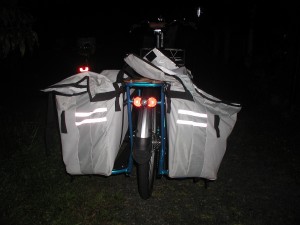 The “Senso” version senses whether it is day or night, and can automatically turn off or adjust the beam to the most appropriate setting. It also handles the rear light, if connected, so that also works automatically.
The “Senso” version senses whether it is day or night, and can automatically turn off or adjust the beam to the most appropriate setting. It also handles the rear light, if connected, so that also works automatically.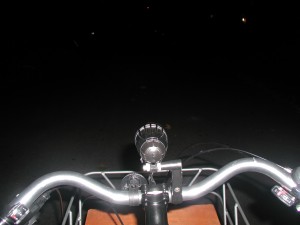 This whole set (back light, Front light and hub dynamo) is between $230 to $330, because the front hub will have to have the wheel around it. Luckily for us living in the US Peter White Cycles sells all these German-made lights, including battery powered versions, in which case the cost is closer to $100 to $150, but you are stuck recharging the 4 AA batteries after every 5 hours of use or so.
This whole set (back light, Front light and hub dynamo) is between $230 to $330, because the front hub will have to have the wheel around it. Luckily for us living in the US Peter White Cycles sells all these German-made lights, including battery powered versions, in which case the cost is closer to $100 to $150, but you are stuck recharging the 4 AA batteries after every 5 hours of use or so.
